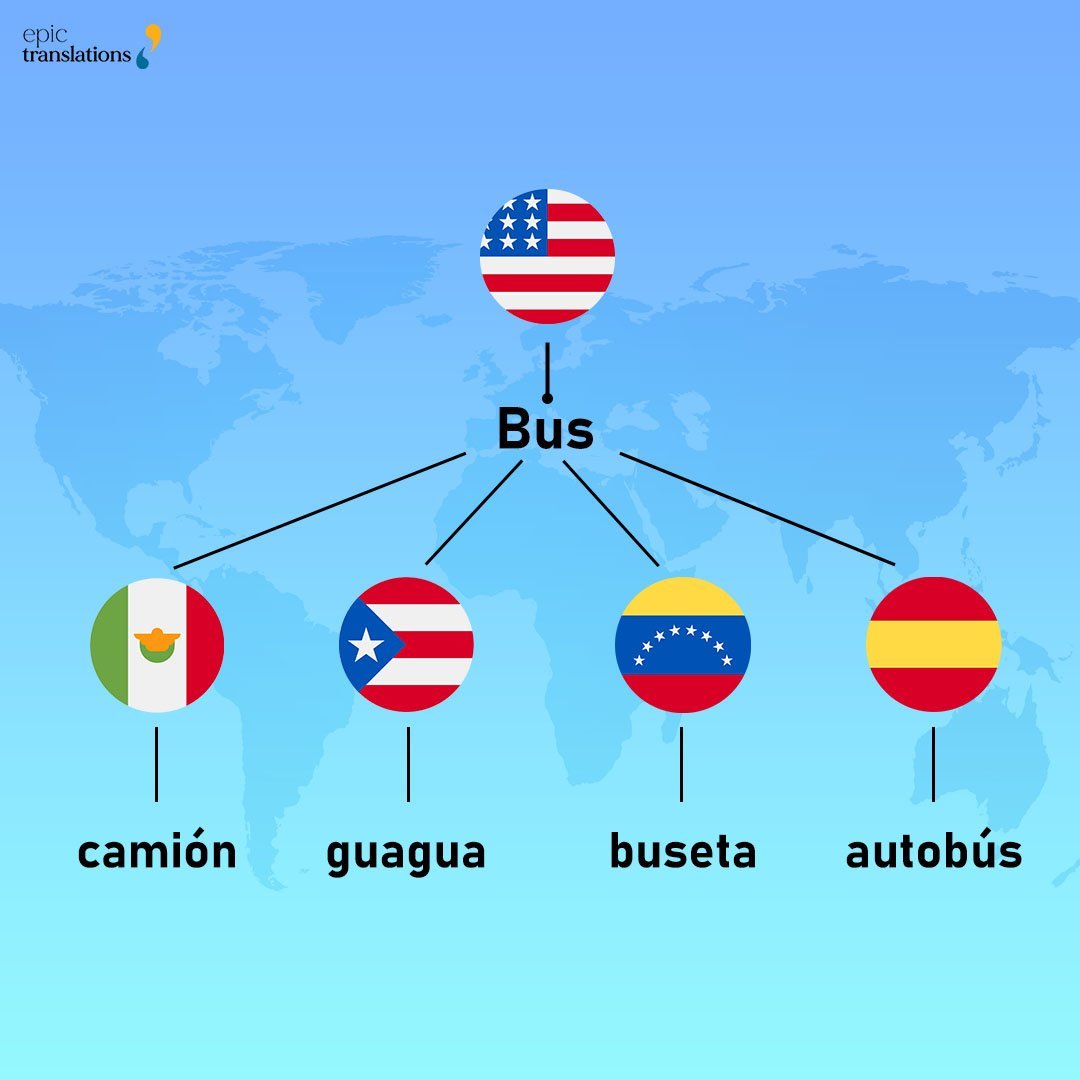
How Many Spanish Speakers Are in the World?
Spanish is ranked fourth amongst the most widely spoken languages in the world, following English, Mandarin, and Hindi. With an astonishing 460 million native speakers, out of 559 million Spanish speakers worldwide, Spanish has the second-highest number of native speakers worldwide (following Mandarin Chinese). Notably, Spanish is the second most spoken language in the United States after English, with 41 million speakers according to the US Census Bureau. Furthermore, it is estimated that by 2050 the United States will have the largest number of Spanish speakers worldwide.
Is English to Spanish Translation Important for My Global Brand?
Undoubtedly, a company that prioritizes communicating with its clients in their native language will gain a strong edge over its competition. If your business operates in any of the below industries, then chances are that English to Spanish translation of your global documents and content has the potential to put you ahead of your competitors.
- Healthcare
- Legal
- Tourism
- Education
- Ecommerce
- Government
Not only does English to Spanish translation of global documents boost the content’s search engine rankings, but it also enhances the brand’s visibility. Moreover, your business could utilize the translated content to enhance their presence across different social media platforms. For instance, with 73% of Hispanic Americans using Facebook, the platform can be utilized as a place to share brand-related information. Additionally, 31% of the 13.1 million Spanish-speaking Instagram users favor profiles with Spanish-language content.

What Should My Company Translate to Spanish?
As previously mentioned, the connection you establish with your customers in translating content into their native language is unparalleled. Below are a few instances of content that should be translated for your Spanish speaking customers:
- Product manuals
- Engineering documents
- Technical specs
- Website copy
- Medical documents
- Legal contracts
- User guides
- Production designs
- Marketing collateral

Is There Location-Specific Spanish Localization?
If your aim is to establish a deep connection with your Spanish-speaking stakeholders and align with their cultural norms and lifestyle, it is crucial that you consider translating your global documents from English to Spanish. Not only will taking this step forward help you stand out from your competitors, but will also help you resonate with your target audience.
Establishing a bond with your target audience plays a vital role in building the aforementioned connection. Consider the power of discussing a shared sport. In the English narrative we can present the example of two buddies attending a baseball game. In Spanish-speaking countries like the Dominican Republic and Cuba, this scenario may resonate deeply with the audience as baseball has significant importance there. However, in countries like Spain and Mexico, where football enjoys a larger fanbase, relating the narrative to football may create a deeper connection with them.
In order to create this localization, your company needs to employ human translators, as they are the only ones who can localize; machine translation software cannot do that. In this instance, they may choose to utilize Translation Memory (TM), which is a tool that human translators use to translate text the same way to ensure consistency in terminology, tone, and style. However, machine translation software, by itself, is not able to understand the culture and dialect of a certain locale, compared to skilled and experienced, native speaking human translators.
Are There Multiple Tones of Spanish?
To optimize your Spanish material, it is important to first decide whether you prefer a formal or informal tone. The choice of tone significantly influences word selection in Spanish, which isn’t necessarily the case in English. Consider, for instance, the word “you” in Spanish. It can be translated in two different ways. Usted is the formal translation, while tú is the informal translation commonly used in South American countries (except for Argentina, where they use the pronoun vos). Mixing up the official and colloquial forms of this word can create inconsistency, which can potentially cause your target audience to disengage from your company brand.
Is Spanish Text Longer Than English?
A Spanish translation will generally have up to 30% more words than the original English text, mainly due to the structural differences between the languages. The longer text can pose challenges to various sectors when there are character and space restrictions. This is a common issue that software and app development businesses frequently face.
The issue is easily remedied when a native translator is utilized, as they will be able to fit the translated text in the allotted space, without compromising the intended meaning of the original text. Prior to undertaking the translation project, it is crucial to prioritize choosing a translator who has a comprehensive understanding of the subject matter at hand.
Are Spanish Vowel and Punctuation Rules Different from English?
The Spanish alphabet has one extra letter compared to the English alphabet.. The word for the letter is eh-nyeh (ñ). While the vowels in Spanish are all acute (á, é, í, ó, and ú), they are all the same (a, e, i, o, and u) as they are in English. This has several uses, including emphasizing a syllable, identifying verb tenses, and separating words with the same spelling.
Are the Numbers Formatted Differently in Spanish?
Unlike English, where numbers are separated by a comma every three digits (i.e. 1,000), Spanish uses periods as thousand separators (i.e. 1.000).
In addition, the two languages have distinct conventions for writing verses, page numbers, postcodes, laws, decrees, and years. To guarantee that your audience can understand the intended meaning of your translated content, it is essential that you adhere to the specific formatting rules of the Spanish language during the translation process.
Think About Using Some English Words in Your Translation
Language borrowing is a common occurrence that has been happening for years. It is not surprising to learn that certain Spanish words have been borrowed from English and vice versa. Spanish, like many languages, uses words from various sources, including English. As is the case, you can find English words being used in topics like television, marketing, and smartphones in Spanish. This is particularly evident in the technology sector, where finding accurate equivalents for new English concepts and inventions is not easy. Interestingly, in certain cases it is better to keep some English terms as they are; it can even benefit your search engine rankings.

Final Reflections
Spanish continues to be a significant language for American businesses, ranking as the fourth most widely spoken language in the world. At EPIC Translations, we have a team of over 20,000 native translators who guarantee quick turnaround times at affordable rates, without compromising the quality of your global document translations.
By trusting your translations to qualified, native, and experienced translators, you can avoid the risk of distorting the message of your content. Poor translations can possibly harm your brand’s reputation. EPIC Translations ensures to preserve the accuracy, relatability, and integrity of your brand.
Start Your Journey with EPIC Translations
We deliver high-impact English to Spanish translations that simplify your communications with your global clients, staff, suppliers, and partners.
Simply put, EPIC Translations exists to support your document translation needs whether you need to translate product manuals, company newsletters, website copy, or legal documents.
Need a quote for your document translation project? Fill out the form below, and we’ll be in touch shortly. Or, give us a call at (888) 214-2053.

How Many Spanish Speakers Are in the World?
Spanish is ranked fourth amongst the most widely spoken languages in the world, following English, Mandarin, and Hindi. With an astonishing 460 million native speakers, out of 559 million Spanish speakers worldwide, Spanish has the second-highest number of native speakers worldwide (following Mandarin Chinese). Notably, Spanish is the second most spoken language in the United States after English, with 41 million speakers in the United States, according to the US Census Bureau. Furthermore, it is estimated that by 2050 the United States will have the largest number of Spanish speakers worldwide.
Is English to Spanish Translation Important for My Global Brand?
Undoubtedly, a company that prioritizes communicating with its clients in their native language will gain a strong edge over its competition. If your business operates in any of the below industries, then chances are that English to Spanish translation of your global documents and content has the potential to put you ahead of your competitors.
- Healthcare
- Legal
- Tourism
- Education
- Ecommerce
- Government
Not only does English to Spanish translation of global documents boost the content’s search engine rankings, but it also enhances the brand’s visibility. Moreover, your business could utilize the translated content to enhance their presence across different social media platforms. For instance, with 73% of Hispanic Americans using Facebook, the platform can be utilized as a place to share brand-related information. Additionally, 31% of the 13.1 million Spanish-speaking Instagram users favor profiles with Spanish-language content.

What Should My Company Translate to Spanish?
As previously mentioned, the connection you establish with your customers in translating content into their native language is unparalleled. Below are a few instances of content that should be translated for your Spanish speaking customers:
- Product manuals
- Engineering documents
- Technical specs
- Website copy
- Medical documents
- Legal contracts
- User guides
- Production designs
- Marketing collateral

Is There Location-Specific Spanish Localization?
If your aim is to establish a deep connection with your Spanish-speaking stakeholders and align with their cultural norms and lifestyle, it is crucial that you consider translating your global documents from English to Spanish. Not only will taking this step forward help you stand out from your competitors, but will also help you resonate with your target audience.
Establishing a bond with your target audience plays a vital role in building the aforementioned connection. Consider the power of discussing a shared sport. In the English narrative we can present the example of two buddies attending a baseball game. In Spanish-speaking countries like the Dominican Republic and Cuba, this scenario may resonate deeply with the audience as baseball has significant importance there. However, in countries like Spain and Mexico, where football enjoys a larger fanbase, relating the narrative to football may create a deeper connection with them.
In order to create this localization, your company needs to employ human translators, as they are the only ones who can localize; machine translation software cannot do that. In this instance, they may choose to utilize Translation Memory (TM), which is a tool that human translators use to translate text the same way to ensure consistency in terminology, tone, and style. However, machine translation software, by itself, is not able to understand the culture and dialect of a certain locale, compared to skilled and experienced, native speaking human translators.
Are There Multiple Tones of Spanish?
To optimize your Spanish material, it is important to first decide whether you prefer a formal or informal tone. The choice of tone significantly influences word selection in Spanish, which isn’t necessarily the case in English. Consider, for instance, the word “you” in Spanish. It can be translated in two different ways. Usted is the formal translation, while tú is the informal translation commonly used in South American countries (except for Argentina, where they use the pronoun vos). Mixing up the official and colloquial forms of this word can create inconsistency, which can potentially cause your target audience to disengage from your company brand.
Is Spanish Text Longer Than English?
A Spanish translation will generally have up to 30% more words than the original English text, mainly due to the structural differences between the languages. The longer text can pose challenges to various sectors when there are character and space restrictions. This is a common issue that software and app development businesses frequently face.
The issue is easily remedied when a native translator is utilized, as they will be able to fit the translated text in the allotted space, without compromising the intended meaning of the original text. Prior to undertaking the translation project, it is crucial to prioritize choosing a translator who has a comprehensive understanding of the subject matter at hand.
Are Spanish Vowel and Punctuation Rules Different from English?
The Spanish alphabet has one extra letter compared to the English alphabet.. The word for the letter is eh-nyeh (ñ). While the vowels in Spanish are all acute (á, é, í, ó, and ú), they are all the same (a, e, i, o, and u) as they are in English. This has several uses, including emphasizing a syllable, identifying verb tenses, and separating words with the same spelling.
Are the Numbers Formatted Differently in Spanish?
Unlike English, where numbers are separated by a comma every three digits (i.e. 1,000), Spanish uses periods as thousand separators (i.e. 1.000).
In addition, the two languages have distinct conventions for writing verses, page numbers, postcodes, laws, decrees, and years. To guarantee that your audience can understand the intended meaning of your translated content, it is essential that you adhere to the specific formatting rules of the Spanish language during the translation process.
Think About Using Some English Words in Your Translation
Language borrowing is a common occurrence that has been happening for years. It is not surprising to learn that certain Spanish words have been borrowed from English and vice versa. Spanish, like many languages, uses words from various sources, including English. As is the case, you can find English words being used in topics like television, marketing, and smartphones in Spanish. This is particularly evident in the technology sector, where finding accurate equivalents for new English concepts and inventions is not easy. Interestingly, in certain cases it is better to keep some English terms as they are; it can even benefit your search engine rankings.

Final Reflections
Spanish continues to be a significant language for American businesses, ranking as the fourth most widely spoken language in the world. At EPIC Translations, we have a team of over 20,000 native translators who guarantee quick turnaround times at affordable rates, without compromising the quality of your global document translations.
By trusting your translations to qualified, native, and experienced translators, you can avoid the risk of distorting the message of your content. Poor translations can possibly harm your brand’s reputation. EPIC Translations ensures to preserve the accuracy, relatability, and integrity of your brand.
Start Your Journey with EPIC Translations
We deliver high-impact English to Spanish translations that simplify your communications with your global clients, staff, suppliers, and partners.
Simply put, EPIC Translations exists to support your document translation needs whether you need to translate product manuals, company newsletters, website copy, or legal documents.
Need a quote for your document translation project? Fill out the form below, and we’ll be in touch shortly. Or, give us a call at (888) 214-2053.
